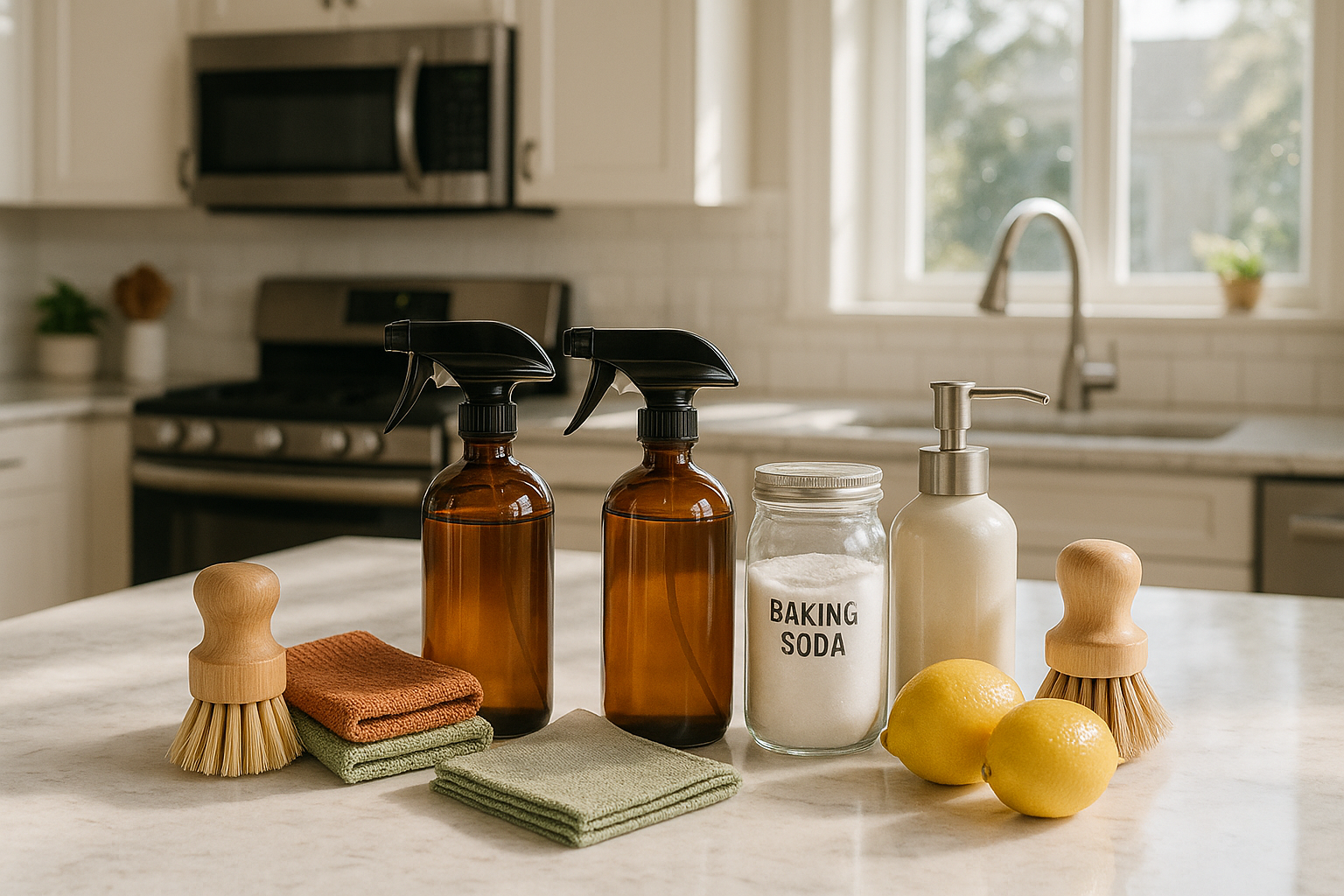Top Kitchen Cleaning Tools and Strategies for a Sparkling, Sustainable Home
A clean kitchen isn’t just about appearances—it’s foundational for your family’s health and safety. This guide explores the best cleaning tools and smart strategies that blend efficiency, wellbeing, and environmental care, helping you create a spotless, sustainable kitchen.
Key takeaways
- Choose cleaning tools that reduce toxic exposure and minimize waste.
- Use microfiber cloths wisely or switch to biodegradable natural fibers.
- Invest in multi-tool kits, HEPA vacuums, and dry steam cleaners for versatile, effective cleaning.
- Select durable, sustainable gloves and sponges to cut down on waste and odors.
- Incorporate sensory elements like natural scents and soft textures to enhance your cleaning experience.
- Look for sustainability certifications and shop thoughtfully to reduce environmental impact.
Table of contents
- Why Choosing the Right Kitchen Cleaning Tools Matters
- Microfiber Cloths: Effective Yet Environmentally Complex
- Multi-Tool Cleaning Kits: All-in-One Simplicity for Every Surface
- HEPA Vacuums: Ideal for Allergen-Prone Kitchens
- Dry Steam Cleaners: Chemical-Free Deep Cleaning
- Gloves and Sponges: Durable and Earth-Friendly
- Laundry Tools for Kitchen Linens: Keep Everything Fresh
- Sensory Appeal: Turn Cleaning into a More Enjoyable Ritual
- Certifications to Look For When Shopping Sustainably
- Cleaning the Kitchen Room by Room: Target with Precision
- Smart Cleaning Tools That Do the Work for You
- Conclusion: Clean Smarter, Live Better
1. Why Choosing the Right Kitchen Cleaning Tools Matters
A well-maintained kitchen not only looks polished—it also guards against foodborne illnesses and reduces allergens. Effective cleaning tools go beyond performance; they help minimize environmental impact and protect your health. Modern innovations focus on:
- Reducing exposure to toxic chemicals.
- Minimizing waste through reusable materials.
- Saving time with multifunctional, ergonomic designs.
Investing in thoughtful, sustainable cleaning tools elevates cleanliness while shrinking your kitchen’s ecological footprint.
2. Microfiber Cloths: Effective Yet Environmentally Complex
Microfiber cloths are renowned for their powerful cleaning ability, capturing grease, grime, and bacteria with just water—removing up to 99% of bacteria when used correctly. Made from ultra-fine fibers like polyester and nylon, they excel on kitchen surfaces.
Environmental Drawback: Microplastics
However, washing microfiber releases plastic microfibers that pollute waterways, harming aquatic life and entering the food chain. Many cloths also contain dyes or chemicals that add environmental risk.
Combating the Problem
To continue benefiting from microfiber without harming the planet:
- Use Guppyfriend laundry bags to trap fibers during washing.
- Wash in cold water on gentle cycles and avoid tumble drying.
- Air-dry microfiber cloths whenever possible.
- Consider switching to natural fiber alternatives like organic cotton, hemp, or linen paired with natural soaps for biodegradability.
Learn more about microfiber’s impact and alternatives
3. Multi-Tool Cleaning Kits: All-in-One Simplicity for Every Surface
Kitchens include many surfaces—from countertops to stovetops—requiring diverse tools. Multi-tool kits consolidate your essentials, saving time and reducing clutter. Must-haves include:
- Sturdy scrubbers like Lodge Scrubbing Pads or stainless steel Scotch scrubbers for tough grease and baked-on messes.
- Detailing brushes such as Full Circle Reusable Plant Towels and OXO Bottle Brushes to reach crevices and corners.
- Absorbent cotton towels like Williams Sonoma or Zeppoli options for drying and wiping.
- Antimicrobial sponges from Skura Style to resist odors and remain fresher longer.
Choose a kit with these to streamline your cleaning process and handle every surface efficiently. Explore multi-tool kits on Amazon
4. HEPA Vacuums: Ideal for Allergen-Prone Kitchens
Accumulated dust, pet hair, and crumbs can aggravate allergies and asthma. HEPA vacuums—equipped with High-Efficiency Particulate Air filters—capture tiny particles without re-releasing them into the air, improving overall air quality.
Notable HEPA Models
- Nilfisk GM 80 – Industrial-grade filtration with powerful suction.
- Nilfisk GD 930 – Affordable with solid performance.
- Shark Apex Powered Lift-Away – Compact and suitable for smaller kitchens.
- Dyson V12 Detect Slim – Cordless convenience plus HEPA purification.
Smart Alternative
The iRobot Roomba i3 is a robotic vacuum with HEPA filtration and smart mapping for autonomous cleaning.
A quality HEPA vacuum improves both cleanliness and convenience in your kitchen.
5. Dry Steam Cleaners: Chemical-Free Deep Cleaning
Dry steam cleaners sanitize without chemicals by using high-temperature vapor to kill bacteria, mold, and viruses on contact. They leave no chemical residues and dry quickly to prevent mold growth.
Ideal for appliances, grout, tiles, and upholstery, top picks include the commercial-grade Ladybug Dry Steam Cleaner and the portable Bissell SteamShot for stovetop grease and grout.
Use steam cleaning alongside daily wiping and vacuuming for a deep, chemical-free cleanse.
6. Gloves and Sponges: Durable and Earth-Friendly
Comfortable, long-lasting gloves and sponges enhance cleaning ease and sustainability. Look for gloves like Casabella Waterblock that prevent leaks and provide dexterity, preferably made from sustainably sourced rubber or natural latex to reduce microplastic pollution.
Traditional sponges can harbor bacteria and odors. Opt for antimicrobial sponges such as Skura Style that stay fresher longer. For greater sustainability, choose biodegradable or plant-based sponges that decompose naturally.
Find sustainable sponges and gloves
7. Laundry Tools for Kitchen Linens: Keep Everything Fresh
Kitchen linens face heavy use from grease and stains. Proper care keeps them sanitary and ensures longevity. Upgrade your laundry routine with:
- Guppyfriend Washing Bag to reduce microplastic pollution.
- Wool dryer balls (see Branch Basics) to soften fabrics naturally and shorten drying time.
- Occasional stripping of towels to remove buildup using safe cleaning agents.
- Drying racks like the Greenco model to air-dry linens and reduce fiber shedding.
These habits protect your textiles and help reduce frequent replacements.
8. Sensory Appeal: Turn Cleaning into a More Enjoyable Ritual
Enhance your cleaning experience by engaging your senses. Natural scents refresh the space and uplift your mood. Favorites include:
- Saint Olio’s Neroli Aromatic Cleaner – a citrus-floral scent free from synthetic fragrances.
- Blueland’s multi-surface cleaner with an eco-conscious formula and cheerful citrus notes.
Textured, soft towels like those from Zeppoli or Williams Sonoma and ergonomic gloves and sponges promote comfort and reduce strain during cleaning tasks, transforming chores into mindful moments.
9. Certifications to Look For When Shopping Sustainably
To ensure your products align with environmental and ethical standards, check for certifications such as:
- Cradle to Cradle: Signifying circular design and safe materials.
- GOTS (Global Organic Textile Standard): Guaranteeing organic content and fair labor practices.
- EPA Safer Choice: Marking products with low toxicity and minimal environmental impact.
Also consider purchasing in bulk or subscription formats to cut packaging waste, favor multi-use over disposable tools, and read consumer reviews for durability insights.
10. Cleaning the Kitchen Room by Room: Target with Precision
Different kitchen areas demand specific tools for best results:
- Sinks and faucets: Detailing brushes like the OXO Bottle Brush tackle mineral deposits and narrow areas.
- Ovens and stovetops: Stainless steel or chainmail scrubbers (e.g., Ringer) remove scorched food safely.
- Countertops and tables: Use gentle microfiber or natural fiber cloths for surface cleaning.
- Floors: Spin mops such as O-Cedar EasyWring provide ergonomic, low-effort control.
- Pest control: Non-toxic fly traps like Terro or Katchy keep bugs away without harsh sprays.
Matching tools to specific zones maximizes efficiency and preserves your energy.
11. Smart Cleaning Tools That Do the Work for You
Smart technology revolutionizes kitchen upkeep by automating tasks and delivering consistent results:
- Robot vacuums like the iRobot Roomba i3 map and clean autonomously, filtering allergens efficiently.
- Electric spin scrubbers reach tricky grout and corner areas effortlessly.
- Spin mops with foot pedals reduce wrist strain and mess.
Embracing technology reclaims your time while maintaining a pristine kitchen.
Conclusion: Clean Smarter, Live Better
A hygienic, beautiful kitchen can be achieved without sacrificing health or the environment. By combining natural fiber cloths, reusable gloves, HEPA vacuums, and steam sanitizers, you create a space that is safe, efficient, and satisfying.
Remember to:
- Reduce microplastic pollution by limiting synthetic cloth use or using Guppyfriend bags.
- Choose certified, earth-friendly cleaning products.
- Embrace versatile, space-saving toolkits.
- Add sensory touches like natural scents and soft textiles.
- Use smart tools to simplify cleaning tasks.
With these strategies, kitchen care becomes a seamless part of your healthy, eco-conscious lifestyle — and your kitchen shines in every way.
FAQ
Q1: Are microfiber cloths bad for the environment?
Microfiber cloths excel at cleaning but shed plastic microfibers when washed, polluting waterways. Using them responsibly—such as washing in Guppyfriend bags, cold gentle cycles, and air-drying—helps reduce this impact. Alternatively, natural fibers like organic cotton or hemp offer biodegradable options.
Q2: What makes HEPA vacuums better for kitchens with allergies?
HEPA vacuums trap tiny allergens like pet dander and dust mites that regular vacuums may blow back into the air, improving indoor air quality. Their sealed filtration is especially beneficial in kitchens where dust and crumbs accumulate.
Q3: Can steam cleaners replace chemical disinfectants?
Dry steam cleaners kill bacteria and viruses using high-temperature vapor without leaving chemical residues, making them a great chemical-free disinfecting option for food prep areas and appliances. They complement regular cleaning routines effectively.
Q4: How can I make my cleaning routine more sustainable?
Choose reusable, certified products, reduce microplastic use, air-dry textiles, avoid harsh chemicals, buy in bulk, and incorporate smart tools that increase efficiency. Supporting natural fibers and biodegradable sponges further lowers environmental impact.
Q5: What certifications should I look for on cleaning products?
Look for Cradle to Cradle for safe, circular products, GOTS for organic textiles and ethical standards, and EPA Safer Choice for low-toxicity formulations. These assure higher environmental and health standards.








